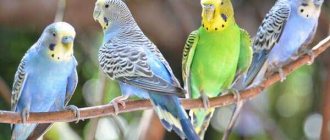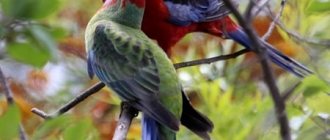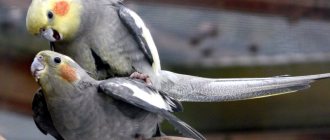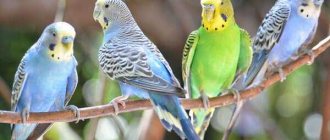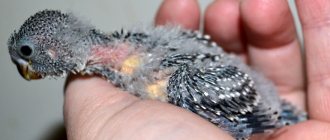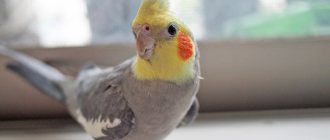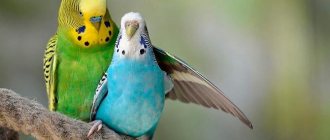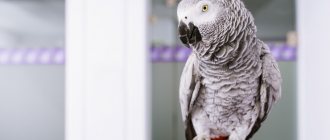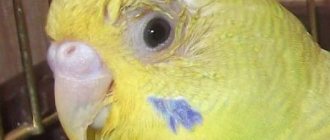Birds are considered the most outstanding musicians on the planet. Among pets, budgerigars are most often distinguished by such skills. They are very small, do not require special care from their owners, and do not claim their free time. These trusting and active birds are favorites not only of children, but also of adults.
In Latin, budgerigars are called Melopsittacus undulatus. Many breeders fell in love with these birds for their ability to remember and repeat phrases and sentences . If you work with them. In addition, melody is felt in the timbre of the voice, so even musical sounds can be freely produced.
Chirping and chirping can be heard in the apartment from morning to night. If there are also parrots, then the singing is not very loud, and the birds seem to help each other. But if the pet is not in the mood, then he can simply remain silent.
How do budgies sing?
These small, colorful parrots are capable of producing a wide range of sounds . Unfortunately, most owners of budgies do not understand why birds make sounds, screams, do not distinguish between chirps, and some simply do not pay attention. In fact, determining what a parrot is tweeting about is very simple. To do this, you need to follow the bird and listen at what speed and intonation it pronounces sounds. After all, every note of their chirping corresponds to an experienced emotion or mood that your pet is trying to convey to you.
Do not be afraid that immediately after purchasing your beautiful budgerigar does not make any sounds. After all, this is completely normal. Your newly adopted pet must get used to the new environment that will now surround it.
Budgerigars are characterized by rapid adaptation to their place of residence and a complete reluctance to change it in the future.
Spectrum of sounds produced
These birds are very observant by nature and begin to copy the sounds they hear at an early age. The urge to sing directly usually manifests itself at the age of 3–6 months.
Such “concerts” begin with the usual chirps and trills for birds, but over time the “repertoire” is replenished with new sounds that attract the parrot. It could be anything: the sounds of household appliances, the tone of human conversations, imitation of other pets.
Beginners often cannot understand what an active pet is signaling. Meanwhile, experienced owners know what signs can be used to determine the condition of a bird. Let's find out what a pet parrot sings about in different situations.
Parrots can be taught to say different phrases to help them better understand their needs.
Video of budgerigars tweeting
Today, there are a lot of videos and audio recordings on the Internet in which budgerigars sing their songs.
List of some Internet sites that provide video and audio files of budgerigars singing:
- https://www. youtube. com/watch? v = KB 1 xKkqwzpI
- http://plus - music. org / video /chirping+budgies+parrots
- http://www. papuga. in. ua / chirikane - volnistyh - popugaev - slushat - online . html
- http://ysatik. com / ptici / soderzhanie - i - uhod - za - popugayami / kak - poyut - volnistye -7328/
Why do parrots shake their heads?
Head shaking is a child's behavior. Chicks wave their heads when asking for food, but this habit often carries over into adulthood. A budgerigar's head shaking and shaking is often a sign of mating. When a parrot wants you to stroke its head, it will shake it. Or your bird just wants food.
Why do budgies stand on one leg?
The one-legged stand is a common sleep position that you can observe throughout the day. A gesture of relaxation to reduce the amount of heat lost. You will find that your parrot may stand on one leg with the other tucked up.
Another sign of relaxation is relaxed body feathers that are held loosely, not tensely.
What do budgies tweet about?
If you decide to learn how to figure out what your bird is all about or why it is chirping displeasedly, then for such a seemingly complex task you will only need patience and attention.
Sounds of budgies:
- Sharp, short, frequently repeated sounds mean that your bird is dissatisfied with something, and perhaps is swearing or indignant. The reason could be anything - an encroachment on her personal territory, dissatisfaction with your movements, and so on. Such indignation, like that of people, will soon pass. Having heard such sounds, experts advise checking the availability of food and its usual living conditions.
- A sound similar to “quacking” is a kind of alarm signal, panic. Thus, parrots protest against something that does not suit them. This may be a reaction to trying to pet, pick up, or force-feed the bird. If your pet is very anxious, along with the sounds, it will also flap its wings and move quickly along the perch.
- Intermittent “quacking” indicates a desire to attract the attention of its relatives. And if there are none nearby, it means the owner.
- Silence and flapping of wings on the sides are a signal of the extreme stage of indignation. Roughly speaking, your bird no longer has “words”, so it silently complains, attracting your attention.
- Silence, accompanied by the parrot's half-closed eyes, communicates the intention to rest and sleep. In such a situation, you simply need to leave the pet alone.
- Measured cooing is the calm tone of a parrot. He's in great spirits. Your budgie is happy with everything. Cooing accompanied by chirping should be a signal to the owner that your bird wants to get a tasty treat and attract attention.
- Singing. For parrots living in the wild, singing is the most common activity during courtship. While in captivity, the bird does this for its own pleasure. Moreover, sometimes parrots perfectly copy the singing of other birds.
It is a widely known fact that parrots are excellent at copying sounds from their environment. And this will not necessarily be the speech of a person or birds outside the window; a parrot may well repeat the sounds of typing on a keyboard, ringing the doorbell and much more. Therefore, if the owner has a desire to teach his pet human speech, then the only obstacle can be the person’s laziness or lack of patience.
A parrot is capable of repeating not only words, but even phrases that sound with the same intonation with which a person pronounced them. Therefore, with the right approach and a reserve of limitless patience, you can start learning . After a while, your beautiful, bright pet will begin to repeat not only words, but also phrases and even entire sentences.
Take a close look at your bird, and you will notice that it has its own character, habits and even habits. Communicate with him, devote at least a couple of minutes of attention to him every day and you will definitely see something interesting.
Teaching a parrot to imitate a human voice
Budgerigars need to be taught to sing when they are very young. It is much more difficult to teach adults to sing, although such cases also occur. Birds know how to listen . It is best to start training one parrot, as it is more difficult to train two. If you have two pets and one of them is already trained to sing or talk, then the training will be much more effective.
- Every day you need to work with your pet on average for a third of an hour. In this case, the parrot will begin to please you within two months. The bird loves when you give it a lot of time and listens to you talk. Repeats words and sounds in gratitude.
- At first, the words should be the simplest, with no more than two syllables. Birds love praise and try their best. Information should be presented with an emotional connotation; budgies, when listening to it, repeat it faster. When the time comes to teach phrases, they should be situationally appropriate to the place.
- If the parrot is indoors for the first time, and the place is unfamiliar to him, he may remain silent for a long time. You shouldn’t demand the impossible from him, let him look around and get used to it. After adaptation, everything will return to normal.
- The best time to study is evening or morning. During the daytime, your feathered pet will give in to sleep. Never force your parrot to do anything he doesn't want to do. Sensitive birds may be frightened by such a rush. It should be noted that these birds are distinguished by their vindictiveness; if they are offended, then for a long time.
Interesting: Kursk pigeons and their role in nature
Reviews
My pets are a male and female budgerigar. They're still talkers. They constantly have conversations with each other. It's a pleasure to watch them communicate. Sometimes I even try to intervene in their conversation, and in response they begin to swear at me. Very funny birds .
I decided that I would gradually study their habits and conversations. They are too businesslike and very similar to us, people. Inna. A budgie was given to me for my birthday. A very beautiful talkative female. I fed her, cleaned her cage, listened to her songs, and that’s it. One day I came across an article that the chirping of wavy animals is a kind of communication with their owners. And I decided to follow my bird. Often my beauty wandered around the cage and flapped her wings on the sides. This interested me and I read what it means. It turned out that she was so indignant and lacked attention . I began to spend time with her more often, talk, play. Our communication has improved and now my beloved pleases me with beautiful songs.
Valeria.
I had a lot of different pets in my house. And I can say with complete confidence that each animal has its own character, just like people. A couple of years ago I had a budgie. By nature he is quite calm and obedient. But, nevertheless, if he was angry and dissatisfied with something, he could bite , while swearing loudly. And yet they are beautiful birds. Their singing is something unimaginable. It’s incredibly nice to come home after work and plunge into this singing. Tamara.
There are six budgies in my house. Equal numbers of females and males. And silence is an extremely rare guest in our house. Birds have interesting conversations with each other around the clock. They discuss something emotionally with gestures, and sometimes it even leads to fights .
Sometimes parrots copy the chirping of birds outside the window. I like to sit down in the evening with a cup of tea, listen and watch their lives, conversations, movements. I'll tell you a very interesting activity. Oksana.
Who is the best singer
Male budgerigars sing best. They can sing both for themselves and for their relatives for a very long time - more than one hour in a row. From a very early age, from three to four months, males begin to make various sounds and cries. Young parrots learn from older, more experienced males. If a bird lives alone in a cage, then it has every chance of quickly learning human speech.
The domesticated parrot sings mainly for its own pleasure. But during the mating season, if there is a female, he is very active: his especially loud cry is accompanied by certain dances.
Female budgerigars behave modestly. Their sounds are calmer. The birds' song is short and not as multifaceted as that of males. Why females are more difficult to teach words.
Health and diseases that parrots are susceptible to
The parrot must be examined daily so as not to miss symptoms of disease. Even with the most proper care, your pet can get sick, and no one is immune from this. It is important to quickly begin timely treatment for budgerigar disease. A bird becomes ill if it develops the following symptoms:
- lethargy, apathy;
- increased thirst;
- growths on the beak, paws;
- poor condition of feathers;
- growth of claws, beak;
- discharge from the eyes, beak;
- decreased appetite.
The main preventive measure to prevent the disease is the correct conditions for keeping and feeding parrots. It is also important to keep the air in the room where the cage is located clean and fresh. Smoking is prohibited and plants that may be poisonous to birds must be removed. You can take care and buy an ionizer and an air humidifier, which are especially needed when breeding parrots.
Infectious and fungal diseases respond well to treatment in the early stages with ointments, drops and antibiotics.
Parrots are amazing birds with a variety of beautiful feather colors that amaze you with their curiosity and intelligence. They become attached to their owner, sociable and friendly.
The bird is trying to talk
Gestures help express friendship. When meeting its owner, the bird may hit its closed beak on an outstretched finger. Such a greeting symbolizes trust and goodwill.
The chirping of parrots differs from other species of birds in its melodiousness. It reveals various intonations and halftones. A simple chirp expresses concern, curiosity, or a pleasant mood. It all depends on the volume level.
Owners like to communicate with their feathered pets in human language. However, the bird does not understand the meaning of the words spoken. For her, the sounds of human speech are a way to express emotions. She reproduces the speech in a good mood, expressing her readiness to communicate.
In addition to natural molting, there is also a stress molting, when the bird is frightened, this is the so-called defensive reaction to fright. If molting occurs due to factors such as drafts, colds or exhaustion of the body, all measures should be taken to solve the problem - move the cage to a place where there are no drafts, adjust the temperature in the room or review the parrot's diet.
Studying the body language of parrots
Parrots are often chosen as the first feathered pets. There is a logic to this - parrots are quite unpretentious in care and maintenance, have an exotic appearance, and many learn to “speak.” But not everything goes smoothly! As evidenced by the editorial mail, owners often complain about the “melancholic” mood of their pets, noting that they seem to lose interest in life and soon die. An article from our British colleagues arrived very opportunely! Let's try together to understand the nuances of parrot behavior!
The parrot sings and whistles all the time. Let's take a closer look at the parrot. How does he spend his time? Sings, whistles, makes other joyful sounds? Then there is nothing to worry about - the bird feels happy. As people say, a real parrot does not shut up even when it goes to bed!
Parrots generally enjoy the sound of their own voice. So, if your pet is surrounded by constant noise, know that he lives in complete harmony!
Other sounds. So, we know that the sound repertoire of parrots is quite rich - they sing, and mutter, and click, and clatter, and even growl dully. Let’s dwell on the last sound in more detail, because this is the highest degree of happiness for your parrot! The purring of a parrot is similar in meaning to the purring of a cat or the wagging of a dog's tail. It’s another matter when, instead of a “dull growl,” you hear a distinct, ringing growl! Not all parrots make this sound, but know that this is a characteristic warning signal that the bird is irritated or unhappy.
By loudly clicking its tongue, the parrot makes it clear: it is time to pay attention to it. You can just talk to him about different topics or even let him out of the cage to stretch his feathers.
Certain species of parrots make loud and rather unpleasant rattling-squealing sounds. You have to get used to these sounds! They indicate either excitement, anger or fear.
How does the parrot behave? Most often, parrot owners complain about their pets self-plucking feathers. Let's limit ourselves to general advice: you should learn to distinguish between the period of molting (when the loss of feathers is a natural process) and the truly stressful state of the bird. In the latter case, the pet looks pitiful - as if it had been seriously beaten by a moth.
In general, the condition of your pet’s feathers can tell you a lot. If, in particular, your feathered friend looks hunched over, stooped, and his feathers stick out in different directions, he is most likely tormented by internal problems and is clearly not healthy.
Look at your pet’s comb (tuft), if any. The bird is noticeably tense, and its crest stands up, indicating that it is very alarmed by something and is ready to defend itself.
What will our eyes tell us? Look into the parrots' eyes more often! Experts say that the eyes of these birds “wink.” In practice, monitor the position of the eyes and superimpose it on the body positions of the bird that we already know. In this case, much from the world of emotions of a feathered pet will be revealed to an attentive observer. Watch how the eyes “run”, what position the bird itself is in, what sounds it makes. And draw conclusions!
Finally, about behavior. It should be noted that little can be hidden from an attentive owner! In between, pay attention to what is going on in the cage. Your pet is busy with something, entertains itself, sings and chirps - it’s quite good for him. Be wary when you see a bird sitting sadly and sadly on its perch. It's hard not to notice! Indeed, it can be stated that the parrot has lost interest in life, is unhappy or even sick.
See how your pet reacts to your approach to the cage. He is actively happy, making noise, his eyes are sparkling, which means everything is going great. The bird remains indifferent, which means it’s time to sound the alarm. Start looking for the reasons - when it all started, what circumstances accompanied it.
Source
